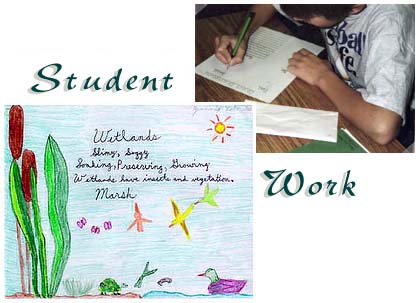
In the images above (l-r):
Poem and drawing done by student from Northpoint Elementary School
Student from Sugar Creek Elementary preparing to write an object description.
Field Trip/Wetland Reflections | Student Fables
Student Fiction | Wetland Information | Wetland Poetry

Field Trip/Wetland Reflections
The trip made me feel that wetlands are pretty neat. I saw a bird nest and some neat grass. I also saw a nest of spiders and a big leaf but we didn't know what kind of leaf it was. I heard birds calling to each other. Also I heard something moving around. I smelled the woods and the pine trees. I feel that nature is surprising and awesome to explore.Chuck, VIT Junior High School
The wetlands were damp and marshy. The wetland habitat was packed with many life forms. I felt like a wetland creature.
Ben R., May School
I can hear the clouds moving about the sky and I can feel the sun's rays warming my back. I can also hear insects buzzing around my head. It's so peaceful that I can hear the wind and almost even see it. The wind is talking to me in a language that I can't understand. I know it's trying to tell me what a beautiful day it is. If I could, I would stay in my spot where I'm sitting, and I would close my eyes and see with my other senses. I know I could do this forever.
Heather T., May School
On the sixth grade field trip I learned, saw, and did many different things. Here is my day.
We left Northpoint School at 7:45 am on our way to a wetland to explore it!! When we got to the wetlands we all got in to our boots, coats, gloves, and hats because it was very cold out there!!!!! Then we got into our groups and set out into the wetlands. First Sarah, Susan, and I went to sample soil with a very nice lady. It was very neat because I learned that the deeper the instrument that brought up the soil got, the color of the soil changed more and more.
We went from there to looking for animals tracks with Mrs. Arns. We found many deer tracks. They were very cool. We also saw what we thought were raccoon tracks. We got muddy looking for these tracks!
After we got done looking at animal tracks with a man named Paul, we saw many different birds. We saw about 5,000 ducks out on the lake. We learned that lakes were kind of pit stops for birds on their way south. We also saw many other neat birds that I am having trouble remembering the names of.
After we got done bird watching we changed from our boots to our regular shoes, got back on the bus and went to Dickson Mounds. It is a very nice museum that is built over an Indian burial ground. Then we went into the building into a room to eat lunch. While we were eating lunch another school put on a nice play for us and we put on a play for them.
After we got done eating we set out into the museum. First we went to see a very informational movie about the way Indians lived. I learned many thing like how important the wetlands were to the Indians. From there we went to see a real Indian burial ground. I thought it would be huge but it was quite small.
Then we went to something called the reflection room. It was very very cool and I learned that babies were sacred to the Indians because they could not talk!! I also learned that they had a party type thing after the harvesting of the crops.
From there went went to look around at the exhibits. I saw many different things like arrowheads, how their huts looked, how they fished and how their hoe looked. That is a very interesting museum!!
When we got done with that we went into a room with many different things to do. First I wove a mini rug out of a plant called a cattail. It was very cool. After that I went to grind corn and drill a hole in a shell with a drill the Indians would have used.
After we did all that we got back on the bus with lots of new knowledge to take home with us!!!!!!!!!!!
Katelynn W., Northpoint Elementary School
Compilation of Rock Falls Middle School students' responses to a questionnaire after a field trip to Nachusa Grasslands and Jay Meiners Wetland.
Favorite part of the fieldtrip:
Least favorite part of the fieldtrip:
- Collecting invertebrates at the marsh
- "No Name Knob"
- Making plaster casts of animal tracks
- Walking through deep mud, deep water, "weeds," etc.
- Waiting for the plaster casts to dry
- Walking so much
Activities recommended not be part of future fieldtrips:
- Walking all the way to the cattails at the prairie pothold
- Getting "bugs" out of the creek
Activities recommended be added to future fieldtrips:
- Keep invertebrates we collect from the marsh
- Have more activities
- Spend more time looking for animals
- Go all the way down to Wade Creek
Other suggestions to help make future field trips better:
- Bring more parents and teachers
- Leave earlier and make it longer
Dear Liz,
I had a lot of fun on our field trip to the wetlands. Thank you for guiding us through part of the Cache River Wetlands. I had lots of fun at Bell Rose Pond too. I learned a lot at the pond. I never knew that there were so many different kinds of macro creatures living in the pond. I had lots of fun and hope that we can preserve the wetlands for years to come.
Sincerely,
Malcolm O., Vienna Public School
Dear Liz,
Thank you for having us. I enjoyed seeing all the neat trees. I liked the swamp and the duck weed. I learned how to identify living things. I enjoyed the trip.
Thanks,
Amanda L., Vienna Public School
Dear Liz,
Thank you for having the 6th grade come to Heron Pond. I learned a lot about different things. Our class really enjoyed it. My favorite part was when we went to sample water. Thanks again for taking the time to help us learn more about the environment.
Sincerely,
Kuly C., Vienna Public School
Dear Mrs. Jones,
Thank you for taking our class to Heron Pond and Belrose. It was fun to see all the animals and plants. I have never seen the sizes of the acorns at Heron pond before. It was real enjoyable. Also the oak tree was huge I couldn't believe how many people it took to get around it. At Belrose it was neat to see all the insects. I had a great time. I hope we can go there again soon.
Sincerely,
Becky F., Vienna Public School
Dear Mrs. Liz Jones,
Thank you for telling us about the birds, trees, vegetation, and the swamp. I enjoyed learning about the great blue heron and the Dutchman creek. The trails were cool too. In the duckweed were trails of animals they told us that too. At Bell Rose the insects in the water were fun. We had a fun time and learned a lot. Thank you very much!
Sincerely,
Sabrina B., Vienna Public School
En wetlands, cuando fui, habia muchas flores como sacate y muchos arboles. Los grillos cantaban. Pormientras otros grillos bailaban arriba del sacate largo, y otros abajo estaban muy bonito. Ademas habian peces y me gusto mucho.
anonymous student, Booker T. Washington School
Lying on the ground I could hear the sound of crickets chirping all around. I could feel some pricks on my back when I was trying to relax. I could hear a plane soaring but I was ignoring it. I was listening to rustling leaves that were blowing in the breeze. A mysterious noise was swishing and I was wishing that I could find out what the noise was.
Chris, Booker T. Washington School
Before the visit to the wetland:
I thought a wetland was a swampy area with a low level of lifeAfter the visit to the wetland:
Yes, my idea changed of a wetland. A wetland is a swampy area, but there is much life in a wetland.Ryan, Lewistown Central Grade School
Before the visit to the wetland:
I thought a wetlands was a muddy part of land with a foot of water and little vegetation.After the visit to the wetland:
Yes, my idea of a wetland changed. I found out it had quite a bit of vegetation.Tyler S., Lewistown Central Grade School
There used to be many more wetlands than there are now.
Scott, Lewistown Central Grade School
I didn't know how good the water was for living things that live in it!
Stephanie D., Lewistown Central Grade School
When I was doing an experiment (at Volo Bog) I saw some tadpoles it looked like they were trying to break through the ice.
One fact is tadpoles are cold blooded, which means they can adjust to cold water.
One more fact is tadpoles swim slower in cold water because their blood is cold. That is what I did when I was at Volo Bog.
Steven P., Beach Elementary School
When I was doing an experiment at Volo Bog I saw some tadpoles in the open water. First I observed them and saw that they were a green-brown color with black spots all over them. I also saw they were developing back legs and they had big round heads. I tried to find out what they were doing. My opinion was that they were breaking the ice with their heads. They were not moving very fast because it was very cold outside. The tadpoles were 2-3 inches long. That was about some tadpoles I observed at Volo Bog.
Jenna C., Beach Elementary School
For our field trip we went to Yellow Slough. We learned that the three ways scientists can tell if a place is a wetland is hydrophytic: vegetation, hydrology, and hydritic soil. We also played relay games and we played a game called quick frozen critters. The field trip was fun.
Kyle M., Gallatin County School
Student Fables
Why the Cypress Tree has Knees
A long time ago there was a tree and this tree's name was Cypress. She lived in a swamp. Cypress was an ugly tree and she disliked being ugly. She asked the animals in the swamp if they could think of something to do about it. One of the animals she asked was the snake. The snake said "Maybe you should move some of the other trees in your way." Cypress thought for a long time. She said "Good idea, Mr. Snake!" Mr. Snake said "I will help you, but on one condition, if you will let me live on you." "Yes!" said Cypress. The two pulled and pushed, but Cypress wouldn't move. So Cypress asked Mrs. Heron, a big bird. She said "If I can live on top of your leaves, I will help you." "Yes," Cypress said. So Mrs. Heron though about what to do. Mrs. Heron simply replied, "Stretch as far as you can." Cypress said "Ok." So they both pulled as hard as they could, but it didn't work. Cypress asked Mr. Toad. Mr. Toad said "Mrs. Heron had the right idea. Pull your hardest, but this time, pull your root, too." Cypress tugged for hours. All of a sudden, the roots pulled free from the water and stuck up and a few days later, Cypress started growing new leaves. Months passed. Cypress grew taller. So Cypress, Mr. Snake, Mrs. Heron, and Mr. Toad lived happily ever after and this is why the Cypress tree has knees.Shane H., Herrin Middle School
Why the Cypress Tree has Knees
The knees on a cypress tree at one time were its legs. Long ago, the trees were alive, like humans. They could walk and talk. The cypress had the most legs of all the trees. One day, the cypress tree became very tired and sat down on the water to rest. The tree sat in the same place for so long, it could no longer move. A very nice snake came along and decided to help the tree. The snake helped him by exercising his legs. He would move them up and down. The snake did this for many years. The snake became very old and died one day while exercising the tree's legs. None of the other animals would ever help exercise the cypress tree's knees, therefore it was never able to move again. To this day, all cypress trees that sit in the water have only their knees sticking out, but they are pretty comfortable now.Brook S., Herrin Middle School
How the Lily Pad Was Formed
Once upon a time there was a little frog that lived in a marsh. His name was Freddy Hopper. He looked like an ordinary frog, but he didn't like water, in fact he hated it. This wasn't so bad except his best friend, Mark Muskrat, live on the other side of the marsh. He desperately wanted to see Mark but he couldn't figure out a way to get across the lake without getting wet. Freddy was a very smart fog though, and he got an idea. He got a teeny, tiny, blow-up life boat and hopped on it. When he landed on it the little green boat bobbed up and down and started to sink. He jumped off just as water started covering it. The green boat surfaced again. Freddy got another miniature boat and jumped on it. The same thing happened. He tried again and again, but to no avail. He looked around, all the little boats had clustered together near some white flowers. The white flowers looked a lot like little cups. That gave him another idea. He tried jumping on one of the flowers. It would have been perfect except it didn't float. Freddy had never been so scared. He though he was going to drown! He leaped out of the flower and hugged a long cattail stem as he watched in horror as the flower rocked dangerously and suddenly flipped over. Freddy decided to try one more idea. He carefully slid one of the flowers onto a discarded boat. He plucked a cattail off its stem. He gently climbed into the white flower. He used the cattail as a paddle and glided smoothly across the silty lake. When he got to the other side he showed off his new invention to Mark."Wow! What are you going to call it?" Mark asked.
"I think," Freddy said thinking hard, "I'll call it Lily Pad, after my mom."
Freddy made many lily pads and let everyone use them, and everyone lived happily ever after!
Ashley H., Sugar Creek Elementary School
How a Large-Mouthed Frog got its Large Mouth
Once there was a little green frog that had a very small mouth. He was smart but very curious, and sometimes his curiosity got the best of him. I am going to tell you a story about how this little green frog with a very small mouth came to be a Large-Mouthed Frog. It was a very beautiful day........................It was a very beautiful day and on this particular day, like many, Bob (who was a little green frog with a very small mouth) was very curious. He wandered around the wetland looking for things he had never seen before. He came across many things that he had already tasted and observed like old tires (which tasted horrible), cattails, types of sedges, bulrushes, and a great many other things. So he wandered farther and farther away from the wetland into the woods while the whole time his keen eyes surveying everything around him.
Then all of a sudden he spotted a long massive brown thing hanging from a tree, suspended in air! He thought to himself, "Hmmmm, I don't think I've ever seen one of these before. I wonder what it tastes like, smells like, feels like, and if anything lives in or on it." All of this time he had been moving closer to it and now he was directly in front of it. He tasted a small sample of it and it tasted good. Then he felt it and it was rough and bumpy. Next he smelled it and it smelled piney and fresh. When he looked to see if anything lived on or inside it he saw billions of tiny bugs inside. A frog's feast! He thought that there must be some all the way up and down the tree. So he knew he had to get this thing into his mouth. Well, that was quite a problem because his mouth was so small and this thing was so big.
Are you wondering how he got this large stick into his mouth? Well, first he opened his mouth as far as it would go (which wasn't very far) and then put one end of his mouth around one end of the stick and stretched and stretched his mouth to the other side of the stick. This done, he felt strange having his mouth open so wide and it hurt the muscles in his mouth. So he figured that he must fill his stomach to his heart's content and then hurry to get his mouth off the stick before his mouth stayed that way. He ate and ate and ate till his stomach was full. Then came the trouble of getting his mouth off the stick! He finally, after much stretching and pulling, got his mouth off the stick, but it was too late. His mouth had been stretched and pulled so much that it was never going to be small again. Bob was very downhearted, and all of his children, grandchildren and so on had large mouths and this is how Large-Mouthed Frogs came to be.
Jackie H., Sugar Creek Elementary School
Student Fiction
Hello! My name is Barbera Evangaline Everette Susanne JoAnn Mariane Bumble. I live at Lake Chautauqua. You might have seen me before. Oh yeah. I'm an ant. I'm only a month old, and I've almost been killed about a hundred times!I really like being able able to live at the wetlands. It's kind of scary that a lot of the wetlands are being destroyed. Where would I live? What about my family? I heard some kids talking about all the pollution that has harmed wetlands. Why do people destroy wetlands? Don't they think about all the animals and what this will do to them? I guess not. This is the second wetlands that I've lived in. The first one was destroyed by developers. They needed the land, but I need a home. People need to realize how they hurt wetlands. I need a home just as badly as they do!
Megan N., Athens Middle School
My Life as a Water Droplet



Hi, my name is Lois. I'm just standing here in a puddle by the ice cream parlor. Watching all these people eat ice cream. Ooh I want some. Inside the puddle are all of my friends. Let's see there is Shanon, Rosa, Janice, Jonelle, Jason, Janelle... There's so many of us! Ah! It's getting hot in here I think I am raising up. Bye everyone! 
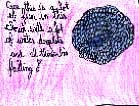
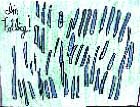
I'm in a cloud now. Gee this is a lot of fun in this cloud with a lot of water droplets and I think I'm falling! I'm falling! 
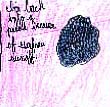

Ouch I just fell onto the cement. That hurts! I'm back into a puddle because of surface runoff. Ah, there's a humongous pink tongue thats slurping me up! 


Well now I'm in a dog! Well the dog went to the bathroom and I'm back in the puddle. Michelle B., Peacock Junior High School
original poster
Wetland Information
Not one organism lives completely on its own. All of the plants and animals live in the marsh together. They all share the space and food of the marsh. They depend on each other for survival. An example of that is an osprey catching a large mouth bass for food. That web was like a system of how the plants and animals depend upon each other for food.Ernie, May School
Three Wetland Indicators
Value of Wetlands
- Presence of hydrophytes - plants that grow in wet conditions, eg. cattails and waterlillies
- Hydric Soil - soil that is saturated with water during a flooding season
- Hydrology - water present in adequate amount to flood the area during the growing season
Angela T., Auburn Middle School
- Provide Habitat - a place for wildlife to live
- Flood Control
- Improve Water Quality
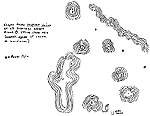
Contour map made by a Rock Falls Middle School Student
Ricardo H., Rock Falls Middle School
Great Blue Heron
It has sharp bills for feeding on animals.
Note its large size, colors, and marking.
Herons frequent lakes, ponds, and marshes feeding mainly on fishes and frogs.
Thirteen species are found in North America.
It's a family with long legged.
It is 38 inches.
It is white, blue and black.Jessie, Cypress Elementary School
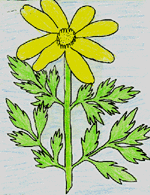
Tickseed Sunflower
The tooth leaves are deeply divided. It's 3-4 foot. The deads turn to follow the path of the sun. The genus Helianthus is made up of the sunflowers. The common sunflower is the most familiar species. It reaches 15 foot sometimes and has huge flower heads over 1 foot in diameter. Western prairies of the United States ate full of sunflowers. Several have been developed.Ashley, Egyptian Middle School
Object Description: Cattail
Paragraph:
Feel: 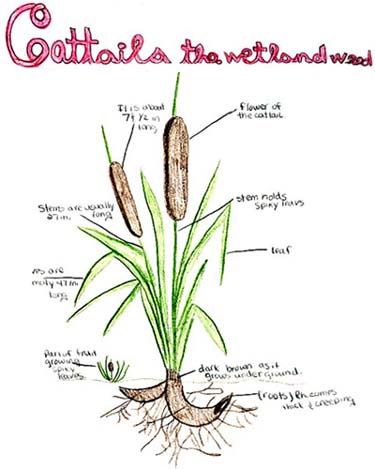
like the outside of a peach fuzzy soft moist spongy smooth (stem) feels like the stem could be
woven in a basketrough Smell: water/moist marshmallows brown sugar peach See: Like a hot dog on a stick round different shades of brown through a magnifying glass it looks
like a beehive or ant housecattail diagram by Joanna, Sugar Creek Elementary School The cattails resemble a peach. It's fuzzy and moist. It smells peachy, too. It smells a little like marshmallows and brown sugar too. Through the magnifying glass it looks like a beehive or an ant house. It was several shades of brown (and a little yellow). The stem was smooth, like a bamboo reed. The brown part is spongy, rough, moist.
Ashley, Sugar Creek Elementary School
I learned about the importance of duckweed. One thing duck weed is used for is to filter the water. Duckweed is also used for fertilizing the bottoms of the wetlands. Duckweed is a hydrophytic plant.
Sarah B., Ward Middle School
The Wetlands
The wetlands are a place were you can learn many things. Three things I learned about are duckweed, Bald cypress trees, and cypress knees.First, I learned about duckweed. Duckweed is one of the smallest plants in the world. It is also a flowering plant. I also learned that duckweed is a hydrophytic plant.
Second, I learned about Bald cypress trees. One thing I learned about them is that they grow in water. Another thing is that they usually grow in Southern states. Also Bald cypress trees lose their leaves.
Last, I learned about cypress knees. Cypress knees stick up out of the water a few feet away form the tree. Some people think the cypress knees anchor the tree in the water. You can find cypress knees on any kind of cypress tree.
In conclusion, the wetlands are a place where you can learn many things. Three things I learned about are duckweed, Bald cypress trees and cypress knees.
Nick E., Ward Middle School
Wetlands
I saw a 1000 year old bald cypress tree. It was in a swamp and had "knees" sticking out all over the place. The "knees" are actually the roots of the tree. It was hard to imagine all the things the tree could tell us about its life it it could talk!We also saw a 100 year old oak tree. We could fit 14 of us all holding hands around it. Officials could have cut it down at any time to count the rings and see how old it was. They didn't to preserve it.
The last thing I learned about was scat. Scat is animal bathroom. We took it apart and thought it was from a fox. Please don't tell a cat to scat!
Nick E., Ward Middle School
I learned about wetlands and their certain soils. The soils of the wetlands are waterlogged, meaning water filled. The soils also feed plants that are hydrophytic, meaning needing water in which to live. Last, the soil is very moist.
Katie S., Ward Middle School
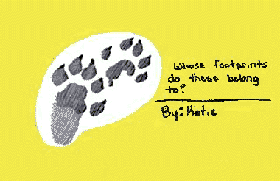
"Whose footprints do these belong to?"
Guide to animal tracks made by Katie, Amboy Junior High School
I learned about many different kinds of wetlands. Swamps are one of the many wetlands. They grow woody plants in them. Marshes have mainly plants that grow with stems partly in and partly out of the water. A bog is wet spongy ground.
Shannon S., Ward Middle School
The last thing I'm going to talk about are three of the benefits (of wetlands). Buffers help protect areas from water and storms. Flood reducers help store water so that nearby rivers and streams don't rise so high. Nurseries are the birthplace of fish and shellfish.
Jamie W., Ward Middle School
Wetlands
Wetlands are being cut down rapidly, and they have many endangered species in them. I have learned that there are three different kinds of wetlands, swamps, marshes and bogs.
First I learned about swamps. Most of the wetlands are swamps. Swamps have mostly woody plants in them. They have some trees over 150 years old.
Then I learned about marshes. In marshes the water level ranges from 0-6 feet. Marshes have plants mostly growing partly above and partly under water. Marshes have few woody plants in them.
Last I learned about bogs. Bogs have very acidy soil. They are formed when water accumulates in shallow depressions made by the eroding of wind, water, and ice. Sedges asphagnum moss, and vegetation gradually encroach the land.
In conclusion, wetlands are being cut down rapidly and there are many endangered species in them. I have learned that there are three different kinds of wetlands, swamps, marshes, and bogs.
Casey R., Ward Middle School
I have learned that wetlands have benefits. Water bands store water to release during drier times of the year. Natural filters purify water by breaking down waste and trapping silt or soils.
Kandace H., Ward Middle School
Wetlands are recreational places. You can go exploring in the woods. There are spots to go canoeing. Wetland have tons of places to fish.
Stephen G., Ward Middle School
The sixth grade of Auburn elementary went to Lake Taylorville on a field trip. There we took water samples to conduct a water quality study. Another activity we did was look for wetland indicators. After these activities we surveyed the land. Our field trip was educational, but also fun.
At Lake Taylorville we took water samples. One of the tests we did was taking the temperature of the water. It was about 75 degrees Fahrenheit. Another test was seeing how clear the water was. For that test, we used a secchi disk. The results varied because the wind created currents that stirred up the silt.
Another activity we did was look for wetland indicators. We looked for hydric soil and hydrophytes and studied the hydrology of the water. Hydric soil is a type of soil that smells like rotten eggs and is colored black and gray. Hydrophytes are the plant inhabitants of the wetland. Arrowheads, water lilies and cattails are just a few examples we found there.
After these activities we surveyed land. We used both electrical and manual surveying equipment. Using the electrical equipment was much easier since we didn't have to look through it. All we had to do was adjust it at the site and raise the measuring bar until it beeped. With the manual equipment it was harder to use because we could only go ten feet high. We had to keep adjusting it, and it didn't beep, so it took much longer.
On our trip to Lake Taylorville we learned a lot. Now we know how to locate a wetland and how to survey an area. Lake Taylorville is a very good example of a wetland. It has hydrophytes, hydric soil and an interesting hydrology. Our field trip was very educational. We learned a lot about wetlands and we also had a lot of fun.
John L., Auburn Elementary School
Whirligigs
Whirligigs, also know as water beetles, are very interesting animals.What makes them so interesting, you ask? Well for one thing, they whirl on top of the water, and they have compound eyes. That means they can see on top of the water as well as the bottom, at the same time!
You will find this interesting. When the whirligig is handled (picked up, attacked, etc.) it produces an apple like scent to make whatever is attacking it, go away.
Whirligigs breathe air, not water. They eat fish and larvae, and they live in freshwater. Whirligigs have flat hind legs, long clawed front legs and short antennae.
In conclusion, Whirligigs are cool. So, the next time you go into a wetland, look for some Whirligigs.
Shawn S., Northpoint Elementary School
Soil Samples
We learned the different kinds of soil. Lyle Reuters field has a lot of clay and sand in it. We learned that water can travel through clay faster than sand because it has more air holes, or pores, than sand does. We talked about the most common thing in the soil was, which was sand. The second common thing in the soil was clay.We also talked about the different colors the soil can be and what the different colors told about the soil type. The colors went from black to a grayish. Soil that is closer to the surface is darker. However, the soil deeper down is lighter. All the way on the bottom was the clay.
On the surface is organic matter, which makes up 5% of the soil. The soil is made up mostly the rest of the way of minerals. These minerals are 45% of the soil. the soil is also composed of 25% air; the air is between particles in the soil. The other 25% of the soil is water that is also in between the soil particles.
Barbara, Jill, Brenda and Kelly, Amboy Junior High School
Wetland Poetry
W is for the water that we walked through Water E is for education that you gave us Evergreens T is for the time you spent with us Tall trees L is for land we did experiments on Lakes A is for the awesome stuff we did Animals N is for nice food Nature D is for the delightful time we had Ditches S is for the sticks that we collected in the fire Sticks Brody R., Jerseyville county Michael K., Jerseyville county
Weeds Wet Eagles Exciting and environment Turtles Terrific archeology Lizards Lots of fun Alligators Awesome information Nice clear creeks No other trip the same Don't always have water Damp area Stops pollution Sludgy mud Russel K. and Jeremy R., Jerseyville County Josiah Z., Jerseyville county
Water snakes and willow trees Water Eggs of birds unseen Environmental Trees everywhere Talking people Land so wet and spongy Lots of trees Animals Animal tracks and scat Nitrates for plants Noises of different kinds Dead plants Duckweed Soggy soil. Soil, dirt and clay Sarah, Jerseyville County Audrey P., Jerseyville County
Wildlife Don't kill nature's helper Endangered Endangered species now extinct Trails A beautiful place gone Lakes Dried up wetland covered with cement. Animals Allison R., Sugar Creek Elementary School Nice and quiet Dense Streams Jenna F., Jerseyville County
Wetlands help us in many ways,
In fact, they help us every single day!
They clean our water for us.
And make it so that there is no fuss.They help save us from water disasters,
They do it even better than the masters!
We can't let our wetlands go to waste,
Or lots of problems will have to be faced.Lisa S., Sugar Creek Elementary School
Wetlands
Wetlands are homes for plants, birds and fish
They are so beautiful they're very hard to miss
They are where frogs can be heard
And a home for the red-winged black bird
Where the arrowheads grow
And the wind does softly blow.
During the day the beavers play
and at night the cattails do sway.
Wetlands are important to me and you, oh my!
We do not want them to die!
So let's all work with each other
To preserve the wetlands for another!Rachel K., Sugar Creek Elementary School
Wetland are lands where cattails, seeds and marshes flow
Where frogs on lily pads lay low
Now you should get my point
So do me a favor
Keep the wetlands cleanMatthew J., Sugar Creek Elementary School
Wetlands are good to stop floods and drought
They help animals without a doubt
Wetlands really help people to lend a hand
Help them spread across the landAndre B., Sugar Creek Elementary School
Wetlands have some real nice creatures,
and some nice shallow water.Keep them here for all to see,
hopefully even your great grand-daughter!Sarmad, Sugar Creek Elementary School
Wetlands (Pro)
Wetlands (Con)
Wetlands, marshes, bogs and streams With vegetation growing thick Fulfill our ecological dreams The wildlife level makes you sick Build a wetland, build a world! The insects biting makes you scream Destroying wetlands is absurd The beautiful prairie seems, A much better place to be! Many animals dwell in there we don't want to destroy them vegetation, insects too All we want to do is enjoy them Too bad we've already made a mistake but if we can fix it soon And then we find some room Then possibly, just possibly we can enjoy a lagoon Anonymous Student, Northpoint Elementary School
Wetlands Poem
I heard crickets chirping Some of them were burping. The leaves turn brown Then they hit the ground. The sun shown bright Oh what a sight. Sit still and listen You might hear some hissin'. Woolly worms so soft and brown Slowly crawl across the ground. We sit on the floor eating our lunch Ms. Plaut's class is a hungry bunch.Anonymous Student, Booker T. Washington School
Eternity
As the birds chirp softly and sweetly,
As the crickets drone at their pitch,
As the secatta buzzes its long hum,
I feel whisked away.And then it was quiet,
As if it were in a different land,
The sounds came closer, then far away
As if it was eternity.Newborns are in the air,
Baby birds are cheeping,
Some were chirpy, others had a song,
Their tunes filled me with life.A tingling tickling feeling,
Went down my spine,
So quiet, so peaceful, so joyous,
That I would never leave.As the last grasshopper chirps
The silent splashing of the stream,
I open my eyes to a pool of water,
And the beautiful sparkling sunAnita, Booker T. Washington School
Wetland Poem
I can hear the bugs and bees. The wind rustling through the trees. The wind blowing through my hair. It makes my skin feel nice and fair. The birds are chirping all around. They are chirp with a happy sound. The edges of the grass blades were sharp and prickly The bugs that sat on them felt very tickly. The warmth of the sun was all around. It was very bright and shone all about the ground. Traci, Booker T. Washington Elementary School
Home | Project Description | Project Participants | Project Personnel | Contributing Organizations | Summer Workshop Series Sites | Wetland Field Trips | Wetlands in the Classroom | Student Work
Last updated
Wednesday, July 09 1997
A. Quackenbush